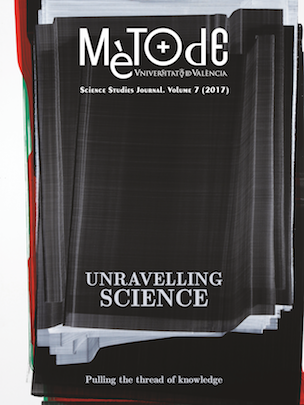From metaphor to action: Embodied language cognition
DOI:
https://doi.org/10.7203/metode.7.7610Keywords:
symbols, embodiment, language, sensorimotor system, emotion Abstract
Abstract
The traditional theories that tried to explain how brain activity leads to cognition used the computer metaphor to describe the way the brain processes information codifying it into symbols that can combine following a finite set of rules. However, recent studies with updated paradigms that used neuroimaging techniques show that the brain activity registered when we observed a brain involved in some cognitive task are the same we would observe if that brain was immersed in perceptual, motor or emotional processing of the information handled for the task. In this article, we review the latest contributions to embodied cognition theories that provide a new approach to human cognition.
 Downloads
Downloads
 References
References
Aboitiz, F., García, R., Bosman, C., & Brunetti, E. (2006). Cortical memory mechanisms and language origins. Brain and Language, 98, 40–56. doi: 10.1016/j.bandl.2006.01.006
De Vega, M., Glenberg, A., & Graesser, A. (Eds.). (2008). Symbols and embodiment: Debates on meaning and cognition. New York: Oxford University Press.
Glenberg, A. M., & Kaschak, M. (2002). Grounding language in action. Psychonomic Bulletin & Review, 9(3), 558–565. doi: 10.3758/BF03196313
Havas, D. A., Glenberg, A. M., Gutowski, K. A., Lucarelli, M. J., & Davidson, R. J. (2010). Cosmetic use of botulinum toxina affects processing of emotional language. Psychological Science, 21, 895–900. doi: 10.1177/0956797610374742
Havas, D. A., Glenberg, A. M., & Rinck, M. (2007). Emotion simulation during language comprehension. Psychonomic Bulletin & Review, 14, 436–441. doi: 10.3758/BF03194085
Martín-Loeches, M., Casado, P., & Sel, A. (2008). La evolución del cerebro en el género Homo: La neurobiología que nos hace diferentes. Revista de Neurología, 46, 731–741.
Martín-Loeches, M., Sel, A., Casado, P., Jiménez, L., & Castellanos, L. (2009). Encouraging expressions affect the brain and alter visual attention. PLoS ONE, 4(6), e5920. doi: 10.1371/journal.pone.0005920
Pulvermüller, F. (2013). How neurons make meaning: Brain mechanisms for embodied and abstract-symbolic semantics. Trends in Cognitive Sciences, 17(9), 458–470
Pulvermüller, F., & Fadiga, L. (2010). Active perception: Sensorimotor circuits as a cortical basis for language. Nature Reviews Neuroscience, 11, 351–360. doi: 10.1038/nrn2811
Santana, E., & De Vega, M. (2013). An ERP study of motor compatibility effects in action language. Brain Research, 1526, 71–83. doi: 10.1016/j.brainres.2013.06.020
Urrutia, M., & De Vega, M. (2011). Lenguaje y acción: Una revisión actual a las teorías corpóreas. Revista de Lingüística Teórica y Aplicada, 50(1), 39–67.
Downloads
Additional Files
Published
How to Cite
-
Abstract1329
-
PDF506
-
Untitled (Español)4
Issue
Section
License
![]()
All the documents in the OJS platform are open access and property of their respective authors.
Authors publishing in the journal agree to the following terms:
- Authors keep the rights and guarantee Metode Science Studies Journal the right to be the first publication of the document, licensed under a Creative Commons Attribution-NonCommercial-NoDerivatives 4.0 International License that allows others to share the work with an acknowledgement of authorship and publication in the journal.
- Authors are allowed and encouraged to spread their work through electronic means using personal or institutional websites (institutional open archives, personal websites or professional and academic networks profiles) once the text has been published.





